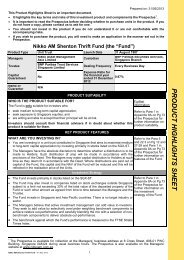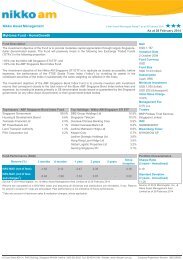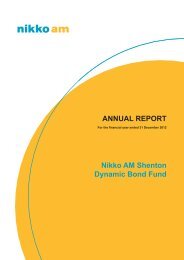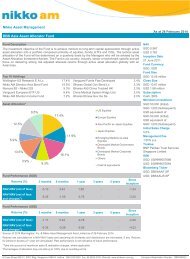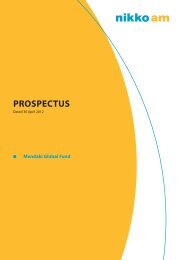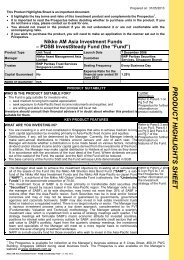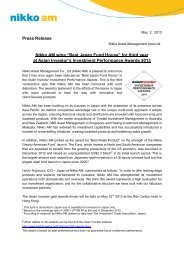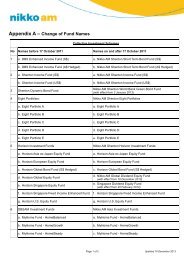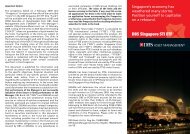ProsPectus - Nikko AM Asia Limited
ProsPectus - Nikko AM Asia Limited
ProsPectus - Nikko AM Asia Limited
Create successful ePaper yourself
Turn your PDF publications into a flip-book with our unique Google optimized e-Paper software.
particular time, the Managers may impose a gate on realisations. If that happens, realisation of Units and/or<br />
the payment of realisation proceeds may be delayed. In addition, holders may not realise their Units during any<br />
period when realisation is suspended.<br />
(e)<br />
Emerging Market Risk<br />
Any investment by any of the Sub-Funds into the Horizon Global Equity Fund which invests in Russell Pacific<br />
Basin Equity Fund, a sub-fund of the RIC, or in Russell Pacific Basin Equity Fund directly will expose the<br />
relevant Sub-Fund to investment risks in emerging markets. Investments in emerging markets securities are<br />
generally more volatile than those of developed countries, with the result that Units in the relevant Sub-Fund<br />
may be subject to greater price volatility.<br />
Some emerging markets do not have well-developed or consolidated bodies of securities laws and regulatory<br />
frameworks. There may be less public information on companies listed on such markets as compared to other<br />
stock markets. The auditing and financial reporting methods used in some emerging markets may differ from<br />
internationally recognised standards, and information on the accounts of some companies listed on such<br />
markets may not be an accurate reflection of their financial strength.<br />
Investors would also have to take into account that trading volume in emerging markets may be substantially<br />
less than in the world’s leading stock markets and may have to be conducted at unfavourable prices. Securities<br />
of companies domiciled in emerging markets are less liquid and more volatile than those domiciled in more<br />
developed stock markets and this may result in fluctuations in the price of the Units. Emerging markets may not<br />
have fully developed custodian and settlement services and therefore investments in such markets are subject<br />
to a greater degree of risk.<br />
There may also be state regulations governing the outward remittance by foreign investors of their share of net<br />
profits and dividends and the repatriation of their investments in a foreign currency.<br />
(f)<br />
Equity Risk<br />
The Sub-Funds may invest in stocks and other equity securities, which are subject to market risks and are<br />
in general more volatile than investment-grade fixed income securities. Units in the Sub-Funds investing in<br />
equities may therefore be subject to greater price volatility.<br />
(g)<br />
Country Specific Risk<br />
The Sub-Funds may invest in securities of a limited number of countries. Where the Sub-Funds invest in a<br />
few, selected countries, it will be exposed to fluctuations in the economies of these countries, and the market,<br />
currency, political, social environment and other risks related specifically to these countries, which may affect<br />
the market price of its investments in these countries. Exposure to a limited number of countries also increases<br />
the potential volatility of the Sub-Funds due to the increased concentration risk as they are less diversified<br />
compared to exposure to specific regional or global markets.<br />
(h)<br />
Risk Associated with the Investment Strategy of the Sub-Funds<br />
The performance of each Sub-Fund is subject to the performance of the underlying funds which it invests in<br />
and also to the proportion of its assets allocated to each of the underlying funds. Holders should be aware that<br />
the Managers have limited discretion to vary the allocations between equities and bonds for each Sub-Fund<br />
(except for Eight Portfolio E which invests only in equities) and this will in turn limit the Managers’ ability to<br />
react to changes in market conditions.<br />
18.1A The risks specific to the Sub-Funds’ investments in the RIC Sub-Funds are as follows:<br />
The following are the principal risks which may affect the RIC Sub-Funds but the list does not purport to be exhaustive:<br />
(a)<br />
Investment Risks<br />
Past performance is not necessarily a guide to the future. The price of shares in the RIC Sub-Funds (“Shares”)<br />
and the income from them may fall as well as rise and an investor may not recover the full amount invested.<br />
There can be no assurance that any RIC Sub-Fund will achieve its investment objective or that a holder of<br />
Shares (“Shareholder”) will recover the full amount invested in an RIC Sub-Fund. As the capital return and<br />
income of each RIC Sub-Fund are based on the capital appreciation and income on the securities it holds<br />
(less expenses incurred), the RIC Sub-Fund’s return may be expected to fluctuate in response to changes in such<br />
capital appreciation or income.<br />
(b)<br />
Equity Risks<br />
Prices of equities fluctuate daily dependent on market conditions. Markets can be influenced by a series of<br />
factors such as political and economic news, corporate earnings reports, demographic trends, catastrophic<br />
11




